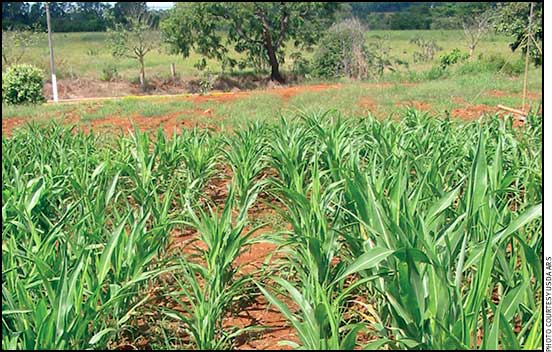
Plant forage sorghum at 12-15 pounds per acre.
Summer Annuals Offer Forage Option
Beef producers can consider summer annuals as additional feed source.
With hay stock levels at record lows in several Midwest states, beef producers looking to supplement their forage options could turn to summer annuals, which are known to thrive in summer heat, are drought tolerant, and can be grazed or stored as feed, according to a forage expert from Ohio State University’s College of Food, Agricultural and Environmental Sciences.
Viable examples include sorghum, Sudangrass, sorghum-Sudangrass hybrids, millet, teff grass and corn, said Rory Lewandowski, an agriculture and natural resources educator for OSU Extension.
These plants have the capacity to produce up to 5 tons of dry matter during summer months, and a majority of them can be grazed or cut two or three times, starting as soon as 30-45 days after planting, he said, which makes them a good option for producers seeking other options amidst reports of declining hay supplies.
Hay stored on U.S. farms as of May 1 totaled 14.2 million tons, which is a 34% decline compared to the same time last year, according to USDA’s May 10 crop production report. Ohio’s hay stocks on May 1 were 140,000 tons compared to 308,000 tons at the same time last year, the report said.
“While most producers are optimistic about the growing season, with the first hay crops looking good at this point, I want to alert producers that there are other opportunities out there,” Lewandowski said. “This way producers are aware of what their options are and have time to do some planning and planting now so they won’t be in a position over the summer wishing they’d known about these options sooner.”
An advantage of summer annuals is that they can be used as a double crop when a previous crop is harvested by the end of June, he said. For example, producers can plant a summer annual after the first or second cutting of alfalfa or after the harvest of barley.
Other advantages: Summer annuals grow fast, mature quickly and can be harvested for stored feed, Lewandowski said.
However, he cautions, forage quality for summer annuals is good at the vegetative growth stage, but declines quickly once the plant reaches its reproductive stage. Extreme dry conditions or drought can also be a concern, Lewandowski said.
“Summer annuals can accumulate nitrates in the lower portions of the stems under drought conditions,” he said. “To reduce the risk of nitrate toxicity in livestock, producers should reduce nitrogen fertilization and make sure livestock don’t graze lower than 8 inches.
“Producers also need to be aware that sorghum, sorghum-Sudangrass hybrids and Sudangrass all have varying levels of potential for prussic acid poisoning if plants are consumed when they are under stress conditions.”
Tips for planting summer annuals include:
- Plant summer annuals when the soil temperature is 60° F-65° F.
- Plant forage sorghum at 12-15 pounds (lb.) per acre.
- Plant millet, Sudangrass and sorghum-Sudangrass hybrids at 25 lb.-35 lb. per acre.
- Plant teff grass at 4 lb.-5 lb. per acre.
- Plant corn used as forage at about 80,000 kernels per acre and seed with a grain drill.
- Soil pH should be 6.0-6.5, soil phosphorus should be at least 15 parts per million (ppm), and soil potassium should be 100-125 ppm.






